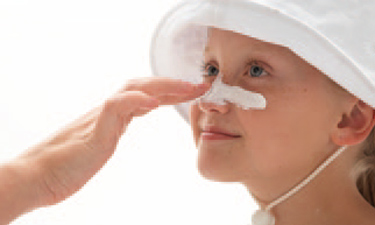 Every year, over one million cases of skin cancer are diagnosed in the United States.
Every year, over one million cases of skin cancer are diagnosed in the United States.
Every hour, one American dies of melanoma, the deadliest form of skin cancer.
And, while genetic factors play a role, the medical community agrees that protecting the skin from birth against the sun’s UV rays is the only real weapon against skin cancer. “We dermatologists tell our patients, ‘The skin is like an elephant,’” says Dr. Elizabeth Martin, a Birmingham, Alabama, dermatologist and youth education chair for the American Academy of Dermatology (AAD). “’It never forgets.’” Martin and her peers at AAD do more than offer statistics and warnings on the dangerous cumulative effects of sun exposure. They volunteer their time—and award tens of thousands of dollars—to equip schools, parks, and childcare facilities with high-quality shade structures for their outdoor play areas.
The applicant groups demonstrating the greatest need and the most robust existing programs of sun safety education receive $8,000 grants to shade their play structures and outdoor amenities. While playground shade structures represent just one of many effective sun prevention strategies, they offer organizations serving children a way to build sun safety into their infrastructure, Martin explains.
Martin points out that, while the facts pertaining to skin cancer prevention are straightforward, myths about sun safety practices nonetheless abound. She cites three in particular:
Myth 1: Installing sun shade structures is an expensive undertaking. AAD makes its sun shade program grants in the amount of $8,000 because this is the approximate cost of sheltering a typical commercial play structure. Whether the shades are metal or treated fabric, and whether the playground is brand-new or older, the AAD grant often covers the cost of covering the play area with UV-blocking shade.
There are certainly far more expensive options for playground shade: Many higher-end, modular shade structures, for example, are created to cover individual components of play systems. But a single rectangular canopy over a play area is an effective, economical way to protect both children and the adults supervising their play.
Myth 2: Skin cancer is an old person’s disease. “Nothing could be further from the truth,” Martin insists. Statistics offer a sobering reminder of skin cancer’s toll on the young. Melanoma is also the most common type of cancer diagnosed in young adults between the ages of 25 and 29 years and the second most common cancer in young people 15 to 29 years old. Even if melanoma were not so prevalent in young people, the cumulative nature of sun exposure reinforces the priority of protecting people of every age, Martin points out. Those who provide outdoor recreation facilities and programs have a responsibility to teach and model sun safety as part of their public service—whether for preschoolers in a tot lot or senior citizens on a golf course, Martin says.
Myth 3: Patrons of parks and pools are the primary target for agencies’ sun protection efforts. “When I see teenagers sitting in lifeguard chairs without umbrellas, I get upset,” Martin says, “Employers of outdoor workers owe it to their staffs to protect them from the sun.” She reflects on one young woman—a melanoma patient she had—who recounted a history of working summers as a lifeguard at a public pool. “Like most pool lifeguards, she had very little sun protection at her job. Her melanoma might have been prevented.”
For employees and patrons alike, the approach to minimizing sun exposure during outdoor recreational time lies in creating a broad culture of sun safety. When employees are trained to practice sun protection habits, they also model skin cancer prevention for patrons—particularly for the children they supervise and teach. But, even more significantly, when managers, planners, and supporting foundations align facility and program design with sun safety priorities, they can make lasting contributions to public health.
The AAD grants program accepts new applications each fall. Applications require demonstrating an established sun safety education curriculum. If your agency is looking to launch or enrich such a public education initiative, Martin recommends “Sunwise,” the free Environmental Protection Agency curriculum available.
Maureen Hannan is Senior Editor of Parks & Recreation.

